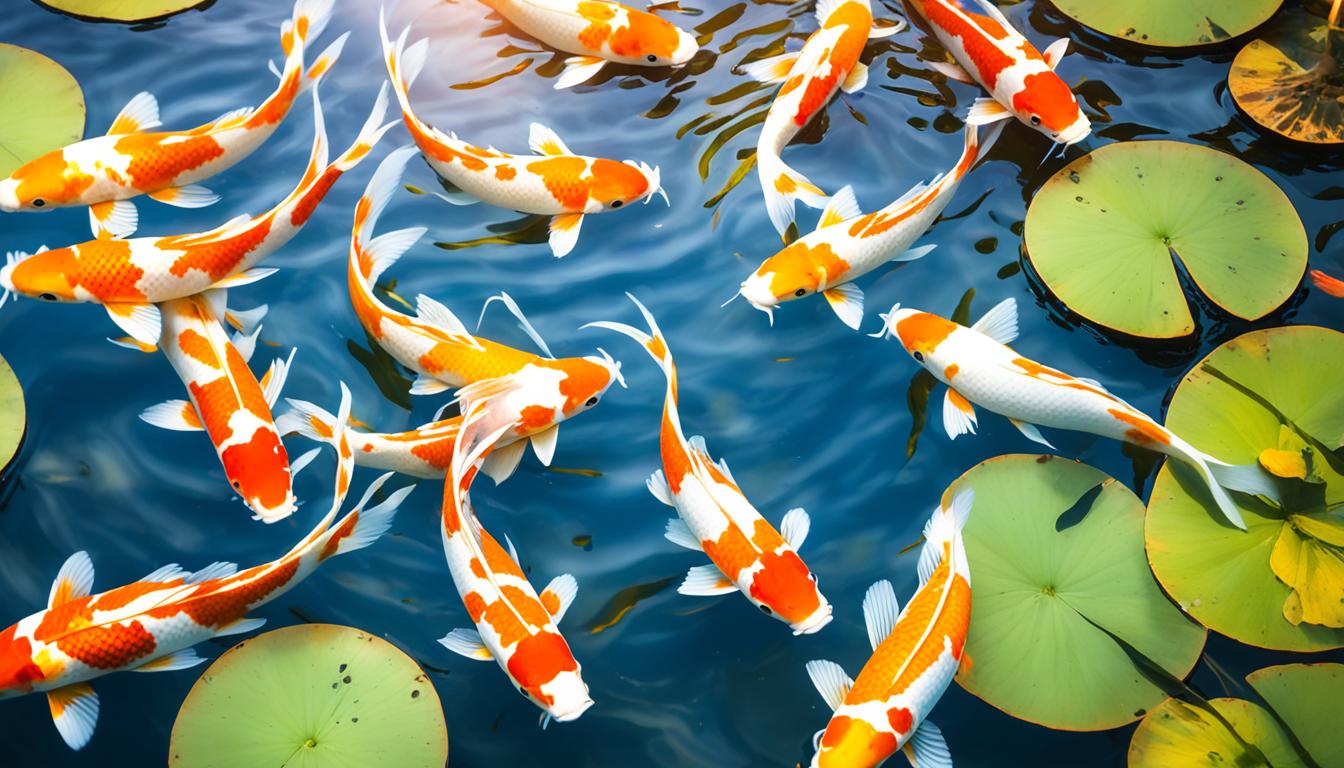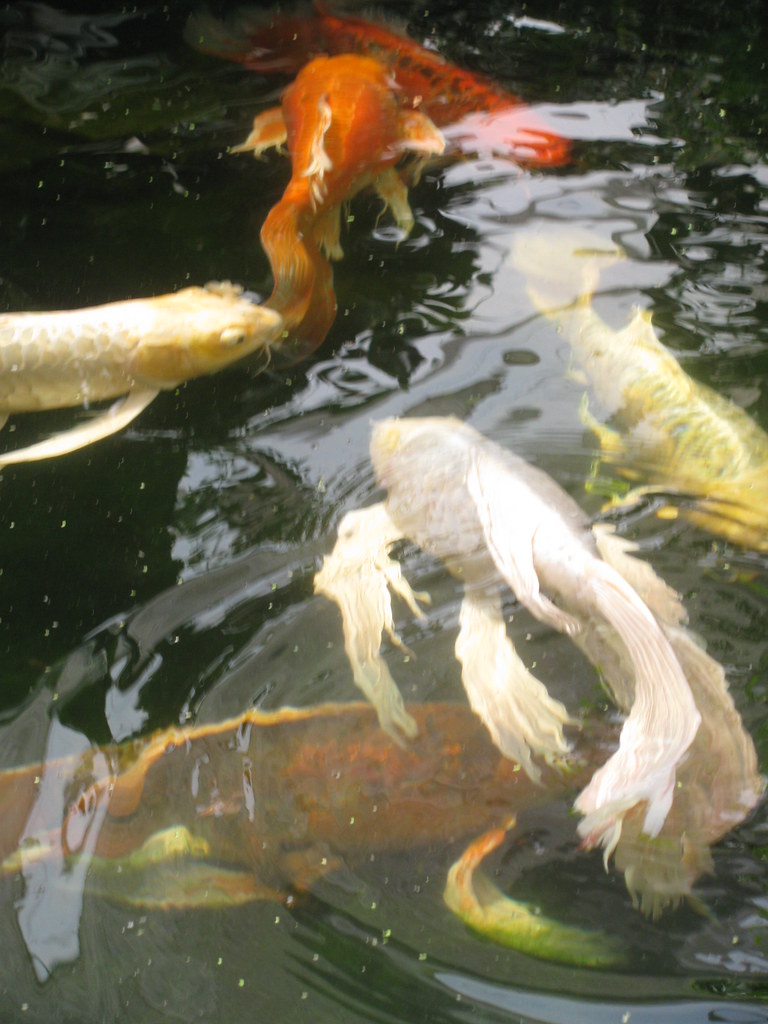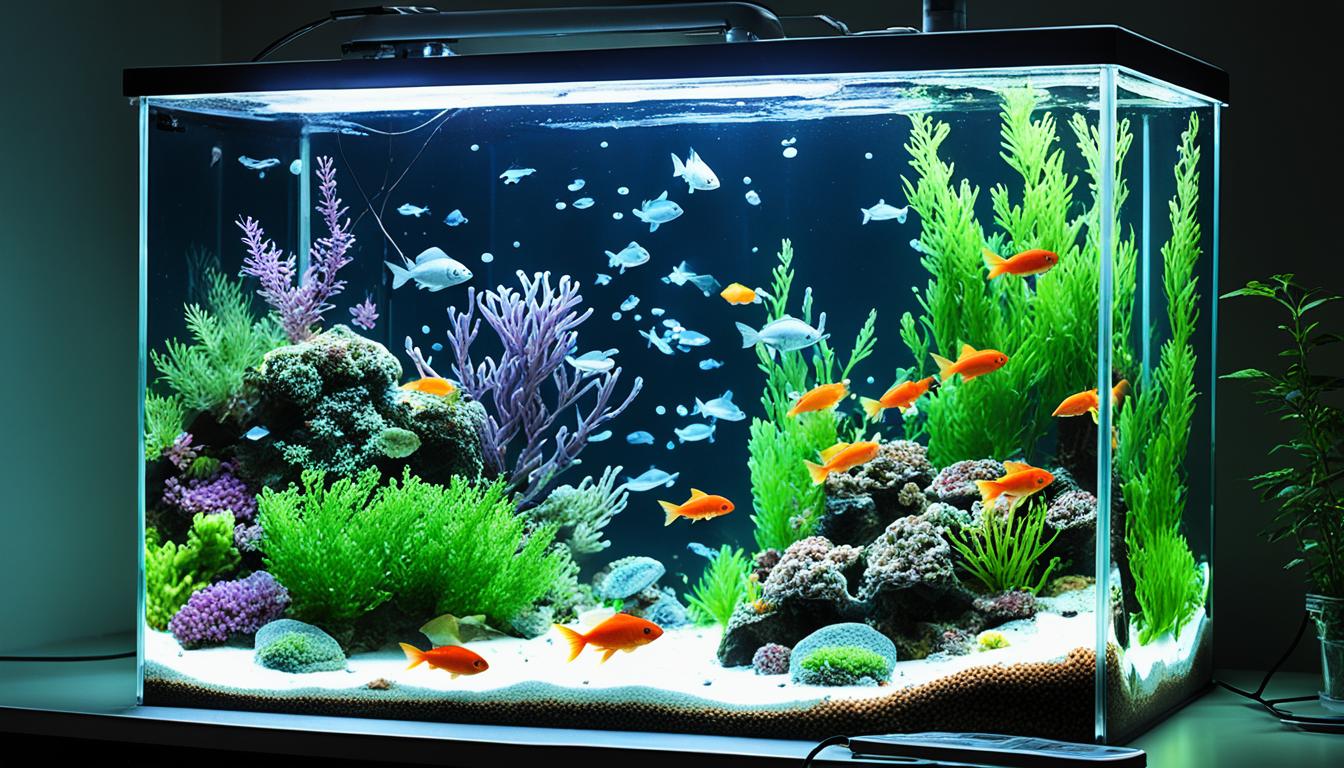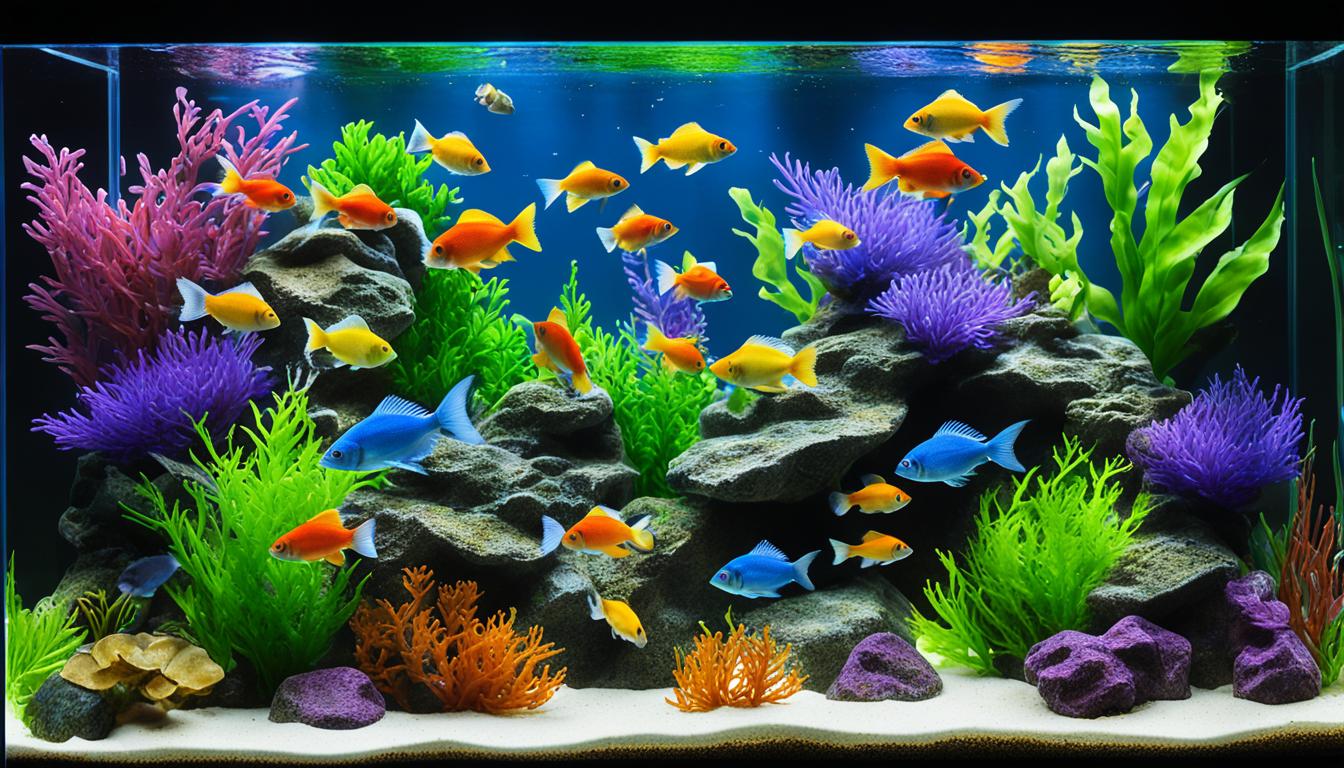Welcome to the intriguing world of butterfly koi fish! These graceful and vibrant creatures are a mesmerizing addition to any koi pond. Whether you are a beginner or an experienced koi enthusiast, understanding the needs and providing the right care for your butterfly koi is crucial for their well-being. From creating the ideal habitat to ensuring their nutrition and health, this comprehensive guide will equip you with the knowledge and tips you need to keep your butterfly koi thriving.
Table of Contents
Key Takeaways:
- Learn about the origin, features, and color variations of butterfly koi fish
- Discover how to set up the perfect koi pond environment for your butterfly koi
- Understand the importance of water quality and maintenance for the health of your fish
- Get insights into feeding and nutrition guidelines for optimal growth and well-being
- Find out about common koi diseases and preventive measures
Understanding Butterfly Koi Fish
Before we delve into the essential care tips for butterfly koi fish, it’s crucial to gain a deeper understanding of their nature and characteristics. By exploring the origin, distinctive features, and various color variations of butterfly koi, we can better appreciate these captivating creatures.
Butterfly koi, also known as longfin koi or dragon carp, are a fascinating variety of koi fish. They are a hybrid breed resulting from the crossbreeding of traditional koi with long-finned Asian carp. This unique combination has resulted in the elongated, flowing fins that distinguish butterfly koi from their counterparts.
One of the most enchanting aspects of butterfly koi fish is the wide range of colors they can exhibit. From vibrant oranges and fiery reds to delicate whites and majestic blacks, butterfly koi display a breathtaking array of hues. Due to their vibrant and striking appearance, they are often a popular choice among pond enthusiasts.
Beyond their captivating appearance, butterfly koi fish possess a graceful swimming style. Their long, flowing fins create an elegant and fluid movement as they glide through the water, adding a sense of tranquility and beauty to any pond or water garden.
Now that we’ve explored the origin, distinctive features, and color variations of butterfly koi, we can move on to the next section, where we will focus on setting up the ideal koi pond to create a thriving habitat for these magnificent fish.
Butterfly Koi Fish Characteristics:
- Hybrid breed resulting from crossbreeding traditional koi with long-finned Asian carp
- Distinctive elongated and flowing fins
- Spectacular range of colors
- Graceful and fluid swimming style
Setting Up the Ideal Koi Pond
Creating a suitable habitat is crucial for the well-being of your butterfly koi fish. A well-designed koi pond provides the perfect environment for your fish to thrive and showcase their vibrant colors. In this section, I’ll guide you on how to design and set up the ideal koi pond, ensuring optimal water quality, filtration systems, and pond size considerations.
Water Quality
Maintaining excellent water quality is essential for the health and happiness of your butterfly koi. Clean and well-balanced water ensures that your fish can swim comfortably and reduces the risk of diseases. Regularly test the water parameters such as pH, ammonia, nitrite, and nitrate levels to ensure they are within the acceptable range for your fish. Consider investing in a high-quality water testing kit for accurate results.
Additionally, install a reliable filtration system that can effectively remove debris and maintain water clarity. A combination of mechanical, biological, and chemical filtration mechanisms will help keep your pond water clean and balanced. Regularly cleaning and maintaining your filtration system will ensure its optimal performance.
Pond Size
The size of your koi pond directly impacts the well-being and growth of your fish. A larger pond provides more swimming space, better water quality, and a more stable environment. Aim for a minimum pond depth of 3 feet to provide sufficient water volume and insulation during colder months.
Consider the number of butterfly koi fish you plan to have in your pond and plan accordingly. As a general guideline, each adult koi requires around 250 gallons of water. Factor in the growth potential of your fish and plan for their future needs.
Design and Landscape
When designing your koi pond, it’s important to create a natural and aesthetically pleasing landscape. Incorporate rocks, gravel, and aquatic plants to provide hiding spots, natural filtration, and oxygenation. These elements not only enhance the visual appeal of your pond but also contribute to the overall ecosystem balance.
Ensure that your pond has a balance of sun and shade to prevent excessive algae growth and provide shelter for your fish. A well-placed pergola, trees, or floating plants can help create a harmonious balance of light and shade.
Pond Size and Stocking Capacity
| Pond Size (Gallons) | Maximum Number of Butterfly Koi Fish |
|---|---|
| 1,000 | 4 |
| 5,000 | 20 |
| 10,000 | 40 |
| 20,000 | 80 |
Note: These are general guidelines. Factors such as filtration capacity, pond shape, and fish growth potential can influence the actual stocking capacity of your pond.
Creating a koi pond that caters to the specific needs of your butterfly koi fish is a rewarding experience. By following these guidelines, you’ll be well on your way to providing a healthy and thriving habitat for your beloved fish.
Water Quality and Maintenance
Maintaining excellent water quality is crucial for the health and well-being of your butterfly koi. Adequate filtration, regular testing, and proper temperature control are essential tasks that ensure your koi thrive in their environment.
Filtration Systems
Investing in a reliable filtration system is vital to maintain clean and healthy water for your butterfly koi. A powerful filtration system will remove debris, excess waste, and harmful chemicals, preventing water contamination and promoting optimal oxygen levels.
There are various types of filtration systems available, including mechanical, biological, and chemical filters. Each filter type serves a specific purpose in removing impurities from the water. Consider consulting with a professional to determine the best filtration system for your koi pond.
Regular Water Testing
Regular water testing is crucial to monitor the pH levels, ammonia, nitrite, and nitrate levels in your koi pond. These key parameters directly impact the overall health and well-being of your butterfly koi.
Test kits are readily available in pet stores or online and are easy to use. Aim to test your water at least once a week and track the results to ensure consistency. Adjusting the water parameters when necessary will help create a stable and safe environment for your koi.
Temperature Control
Butterfly koi thrive in water temperatures between 65°F and 75°F (18°C and 24°C). Fluctuations in temperature can cause stress and compromise the immune system of your koi.
During hot summer months, consider providing shade or using a pond cooling system to prevent the water from becoming too warm. In colder climates, a pond heater or de-icer can help maintain a suitable temperature during winter.
Maintenance Tasks
In addition to filtration, testing, and temperature control, there are other maintenance tasks essential for keeping your koi pond in optimal condition:
- Regular water changes: Replace about 10-20% of the pond water every 1-2 weeks to remove accumulated toxins and keep the water fresh.
- Remove debris: Skim the pond surface and use a pond net to remove fallen leaves, twigs, and other debris.
- Prune plants: Trim overgrown aquatic plants to maintain a balanced ecosystem and prevent overcrowding.
- Clean filters: Regularly clean and maintain your filtration system according to the manufacturer’s instructions to ensure optimal efficiency.
By diligently performing these maintenance tasks, you will create a clean, well-balanced environment for your butterfly koi fish, promoting their overall health and vibrant colors.
Proper water filtration and regular maintenance are key to providing a thriving habitat for your butterfly koi fish.” – Me
| Water Quality Parameter | Ideal Range |
|---|---|
| pH Level | 7.0-8.0 |
| Ammonia | 0 ppm |
| Nitrite | 0 ppm |
| Nitrate | |
| Water Temperature | 65°F – 75°F (18°C – 24°C) |
Feeding and Nutrition
Providing optimal nutrition is crucial for the well-being and growth of your butterfly koi fish. By following a carefully planned feeding schedule and selecting the right food, you can ensure their health and enhance their vibrant colors. Here, I’ll guide you on the best practices for feeding and nutrition to keep your butterfly koi thriving.
Feeding Schedule
Establishing a consistent feeding schedule is essential for maintaining a healthy diet for your butterfly koi. Feed them 2-3 times a day, ensuring that you offer small portions that they can consume within a few minutes. Overfeeding can lead to poor water quality and health issues, so it’s important to avoid excessive feeding.
Suitable Koi Food Options
When choosing food for your butterfly koi, opt for high-quality koi pellets or flakes that are specifically formulated for koi fish. These foods contain a balanced combination of essential nutrients, vitamins, and minerals to support their growth and overall health. Look for reputable brands such as Hikari, Tetra, or Saki-Hikari, which offer a variety of koi food options.
Proper Portion Control
Ensuring proper portion control is crucial in preventing overfeeding and maintaining good water quality. Offer an amount of food that your butterfly koi can consume within 5 minutes. If there is any leftover food after that time, remove it promptly to prevent it from decomposing and affecting the water quality.
Tip: Avoid feeding your butterfly koi fish during the winter months when their metabolism slows down. They may require a specialized winter diet or no feeding at all, depending on the water temperature. Consult with your local aquatic experts or koi breeders for advice on winter feeding guidelines.
Variety in Diet
To promote a well-rounded diet and enhance the natural colors of your butterfly koi, consider supplementing their pellet or flake diet with occasional treats such as live or frozen foods. Daphnia, bloodworms, and brine shrimp are excellent options that will provide essential proteins and nutrients. However, treats should only make up a small portion of their diet and not exceed 10% of their overall food intake.
Observing Feeding Behavior
While feeding your butterfly koi, take a moment to observe their behavior. Healthy koi fish are active and eagerly swim towards the food. If you notice any changes in their feeding habits, such as loss of appetite, abnormal swimming patterns, or excessive weight loss, it could be a sign of underlying health issues. In such cases, consult a veterinarian specialized in fish or seek guidance from experienced koi enthusiasts.
By following these feeding and nutrition guidelines, you can ensure the well-being and optimal development of your butterfly koi fish. Providing them with a balanced diet and maintaining a proper feeding schedule will contribute to their overall vitality and showcase their stunning beauty in your koi pond.
Disease Prevention and Treatment
Just like any living creature, butterfly koi fish are susceptible to certain diseases. It is important to be aware of common koi diseases, their symptoms, and preventive measures to keep your butterfly koi fish healthy. Additionally, understanding appropriate treatment options is essential to ensure their well-being.
Common Koi Diseases
1. Ich (Ichthyophthirius multifiliis): Also known as white spot disease, ich is a parasitic infection characterized by small white spots on the fish’s body.
2. Dropsy (Renal Failure): Dropsy causes the fish to appear swollen due to fluid retention. It is often a symptom of underlying health issues.
3. Columnaris (Flexibacter columnaris): Columnaris is a bacterial infection that commonly affects the skin, fins, and gills of koi fish.
Symptoms of Koi Diseases
- Loss of appetite
- Abnormal swimming behavior or lethargy
- Physical abnormalities like lesions, ulcers, or fin rot
- Respiratory distress
- Excessive mucus production
- Inflammation or discoloration of the skin
Preventive Measures
- Maintain good water quality by conducting regular water tests and ensuring proper filtration.
- Quarantine new fish before introducing them to your main pond.
- Provide a well-balanced and nutritious diet to enhance the immune system of your butterfly koi.
- Implement a regular cleaning and maintenance routine for your koi pond.
Treatment Options
If your butterfly koi fish become sick, prompt diagnosis and appropriate treatment are crucial. It is recommended to consult with a veterinarian experienced in koi diseases. Treatment options may include:
- Medication to target specific infections or parasites.
- Isolating the affected fish in a separate quarantine tank to prevent the spread of diseases.
- Topical treatments for external infections.
- Supportive care, including proper nutrition, temperature management, and stress reduction.
By being proactive in disease prevention and knowledgeable about treatment options, you can help ensure the health and well-being of your butterfly koi fish.
Breeding Butterfly Koi
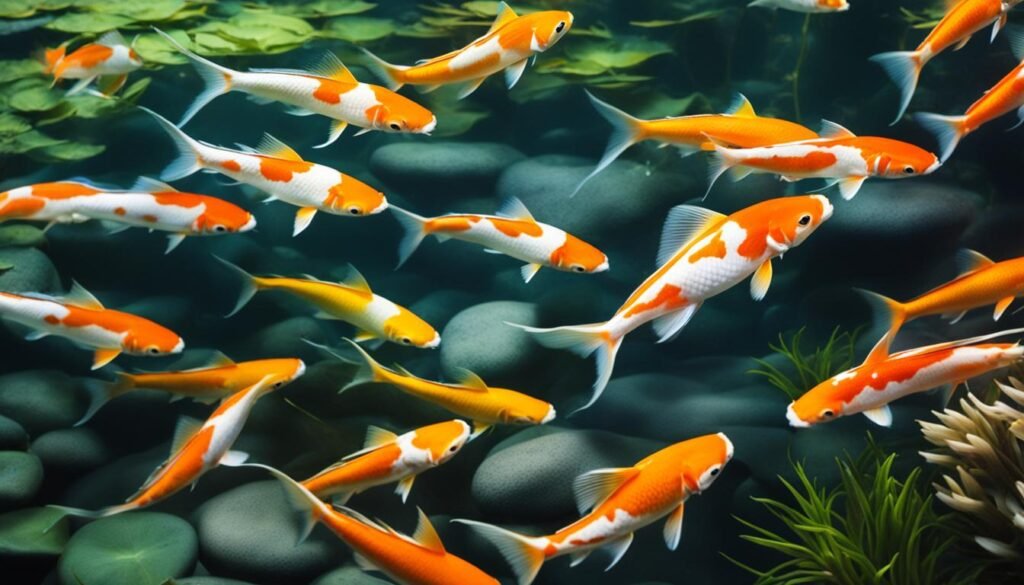
If you’re interested in breeding your butterfly koi fish, you’ll need to understand the intricate process and create the ideal conditions for successful reproduction. Breeding butterfly koi can be a rewarding experience that allows you to witness the growth and development of the fry (baby koi), but it requires careful planning and attention to detail.
1. Selecting Breeding Stock
To start the breeding process, you’ll need to choose suitable breeding stock. Look for healthy and mature butterfly koi that exhibit desirable traits and coloration. Select a male and female pair that complement each other aesthetically and genetically to produce offspring with the desired characteristics.
2. Creating Breeding Conditions
Once you have your breeding pair, you’ll need to create the right conditions for them to spawn. Provide a separate breeding tank or isolated section within the pond where the water temperature can be controlled and maintained at around 75-80°F (24-27°C). This temperature range stimulates the breeding instincts of butterfly koi.
3. Inducing Spawning
To induce spawning, you can try several methods, including gradually raising the water temperature or adding natural cues like rainwater or water changes. Some breeders also use hormonal treatments to trigger spawning, but this should be done under the guidance of a knowledgeable professional.
4. Egg Collection
After successful spawning, the female butterfly koi will lay eggs on the pond floor or any available surfaces nearby. Monitor the breeding area closely and be prepared to collect the eggs promptly to protect them from being eaten by the adults or other pond inhabitants.
5. Fry Care
Once the eggs hatch, you’ll have fry (baby koi) that require special care. Prepare a separate rearing tank with suitable water conditions, including consistent temperature and appropriate filtration. Feed the fry with high-quality, finely crushed food several times a day to ensure their growth and development.
Pro Tip: It’s essential to monitor the water parameters regularly and maintain optimal conditions for the fry’s health and survival. Provide adequate hiding spaces and maintain water quality to prevent diseases and maximize their chances of survival.
Selecting and Buying Butterfly Koi Fish
When it comes to expanding your butterfly koi collection, choosing high-quality fish is of utmost importance. The health and vitality of your new butterfly koi will greatly depend on the selection process. In this section, I will guide you on how to select healthy butterfly koi fish, what to look for when making a purchase, and where to find reputable sellers.
1. Choosing Healthy Butterfly Koi
When selecting butterfly koi fish, there are several factors you should consider to ensure their well-being:
- Physical Appearance: Look for vibrant colors, smooth, unblemished skin, and straight, well-formed fins. Avoid fish with signs of injury, such as missing scales or torn fins.
- Active and Alert: Observe the fish swimming actively and alertly in the tank. Avoid fish that appear lethargic or disinterested.
- Balance and Proportion: Check that the butterfly koi has a well-balanced body shape and proportionate features. Avoid fish with disproportionately small or large body parts.
- Clear Eyes and Gills: Ensure that the fish’s eyes are clear, bright, and free from any cloudiness or bulging. Additionally, check that the gills are clean and not swollen.
2. Inspecting the Seller
When purchasing butterfly koi fish, it is essential to buy from reputable sellers who prioritize the health and well-being of their fish. Here’s what to look for when considering a seller:
- Reputation and Reviews: Research the seller’s reputation online and read reviews from previous customers. Look for sellers with positive feedback and a track record of providing healthy fish.
- Observing the Environment: If possible, visit the seller’s premises to observe the conditions in which the fish are kept. A clean and well-maintained environment is a good indicator of the seller’s commitment to fish health.
- Providing Documentation: Ask the seller for any relevant documentation, such as health certificates or quarantine procedures. This shows that the seller takes the necessary steps to ensure the health of their fish.
3. Where to Find Reputable Sellers
There are various sources where you can find reputable sellers offering butterfly koi fish for sale:
- Koi Farms: Koi farms specialize in breeding and selling high-quality koi fish, including butterfly koi. Research and find reputable koi farms in your area or online.
- Koi Shows and Exhibitions: Attend koi shows and exhibitions to meet breeders and enthusiasts who may have butterfly koi for sale. These events often provide an opportunity to see the fish in person before making a purchase.
- Online Marketplaces: Online marketplaces such as dedicated koi websites or classifieds can connect you with reputable sellers who ship butterfly koi fish directly to your location.
By following these tips and guidelines, you can confidently select and purchase healthy butterfly koi fish to add to your collection. Remember, investing in high-quality fish ensures their long-term well-being and the enjoyment they bring to your koi pond.
Interesting Facts about Butterfly Koi Fish
Butterfly koi fish are not only visually stunning but also have a rich history and unique characteristics that make them fascinating creatures. In this section, I’ll share some interesting facts and trivia about butterfly koi fish that will deepen your appreciation for these captivating aquatic beauties.
1. Origin
Butterfly koi fish, also known as longfin koi or dragon carp, were first developed in the 1980s in the United States. They are a crossbreed between traditional koi fish and Asian carp. This hybridization resulted in their distinctive long flowing fins and elegant appearance.
2. Color Variations
Butterfly koi fish come in a wide range of stunning colors and patterns. From vibrant oranges and reds to soothing blues and whites, these fish add a splash of beauty to any pond or water garden. Some of the most popular color varieties include Kohaku, Sanke, Showa, and Ochiba.
3. Size and Growth
Compared to traditional koi, butterfly koi fish have the potential to grow larger. Although their growth rate varies, they can reach an impressive length of up to 36 inches (91 cm) or more in the right conditions. However, it’s important to note that their growth depends on factors like food, water quality, and pond size.
4. Graceful Swimmers
One of the captivating aspects of butterfly koi fish is their graceful swimming style. Their long, flowing fins create a mesmerizing effect as they glide through the water, adding a touch of elegance to your pond or water feature.
5. Lifespan
In optimal conditions, butterfly koi fish can live for several decades. With proper care, some individuals have been known to live up to 25 years or more. This long lifespan allows you to enjoy their beauty and presence for many years to come.
6. Hardy and Resilient
Butterfly koi fish are hardy and resilient, making them suitable for a variety of climates. They can adapt to different water conditions and are able to withstand colder temperatures, making them a popular choice for koi enthusiasts around the world.
7. Symbolism
In Japanese culture, koi fish hold significant symbolism. They are often associated with perseverance, transformation, courage, and good luck. The unique beauty of butterfly koi fish adds to the symbolic meaning they hold, making them a beloved choice for ponds and gardens.
| Interesting Facts about Butterfly Koi Fish | |
|---|---|
| Origin | Butterfly koi fish were developed in the 1980s in the United States as a crossbreed between traditional koi fish and Asian carp. |
| Color Variations | Butterfly koi fish come in a wide range of colors and patterns, including Kohaku, Sanke, Showa, and Ochiba. |
| Size and Growth | Butterfly koi fish can grow up to 36 inches (91 cm) or more in length, depending on factors like food, water quality, and pond size. |
| Graceful Swimmers | Their long, flowing fins create a mesmerizing effect as butterfly koi fish gracefully glide through the water. |
| Lifespan | With proper care, butterfly koi fish can live for several decades, with some individuals reaching over 25 years of age. |
| Hardy and Resilient | Butterfly koi fish are adaptable to different water conditions and can withstand colder temperatures. |
| Symbolism | In Japanese culture, koi fish represent perseverance, transformation, courage, and good luck. |
These intriguing facts about butterfly koi fish showcase their captivating nature and make them a beloved addition to any water feature. Now that you have a deeper understanding of these stunning creatures, you can further appreciate the beauty they bring to your pond or garden.
Creating a Beautiful Butterfly Koi Display
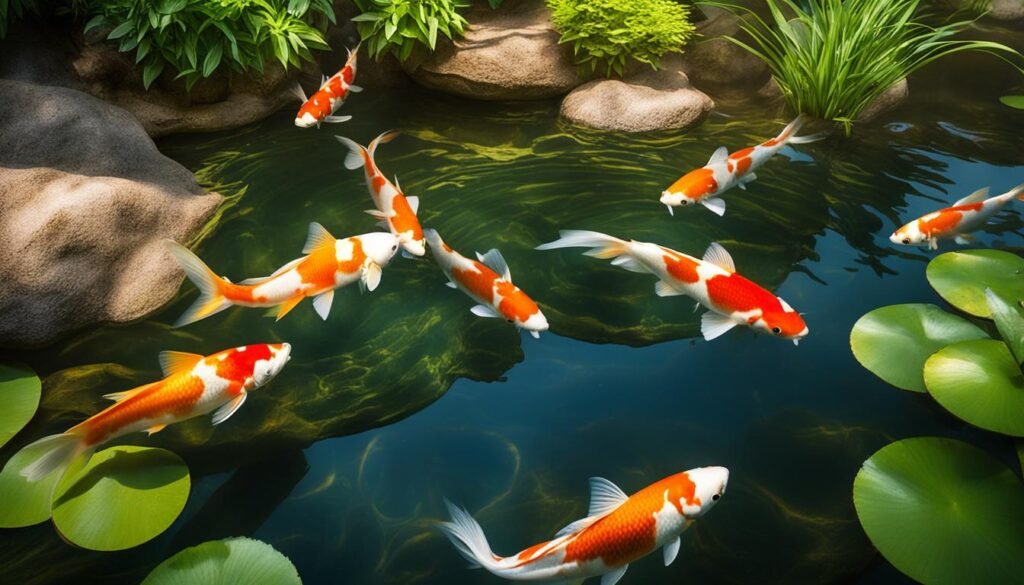
When it comes to butterfly koi care, it’s not just about providing a healthy environment for your fish. These elegant creatures can also add a touch of enchantment to your outdoor space. Here are some creative tips and ideas to help you create a visually appealing display that showcases the elegance and grace of your butterfly koi.
- Choose a stunning backdrop: Create a backdrop that complements the vibrant colors of your butterfly koi. Consider using a beautifully painted mural, a lush garden wall, or a decorative waterfall as a backdrop for your koi pond.
- Add floating plants: Floating plants, such as water lilies or lotus flowers, not only enhance the beauty of your koi pond but also provide shade and shelter for your butterfly koi fish. Their floating leaves create a visually stunning effect.
- Introduce underwater lighting: Illuminate your koi pond with underwater lights to create a mesmerizing effect. Choose soft and subtle colors that highlight the natural beauty of your butterfly koi.
- Accessorize with rocks and driftwood: Use natural elements like rocks and driftwood to add texture and depth to your koi pond. These elements not only create a more natural habitat for your fish but also add visual interest to the overall display.
- Create a seating area: Make your koi pond a place to relax and enjoy. Set up a comfortable seating area near your pond where you can sit back and watch the graceful movements of your butterfly koi. Add a table and some plants to create a cozy atmosphere.
By incorporating these creative ideas into your outdoor space, you can create a captivating display that not only showcases the beauty of your butterfly koi but also provides a serene and magical ambiance.
Enhance your outdoor space with a visually stunning display that showcases the elegance and grace of your butterfly koi. From selecting a beautiful backdrop to incorporating natural elements, there are endless possibilities to create a captivating atmosphere for your fish. Let your creativity shine and enjoy the enchantment of your butterfly koi display.
Conclusion
In conclusion, this comprehensive guide has provided valuable care tips and advice for raising butterfly koi fish. By implementing these guidelines, you can ensure the health, vibrancy, and visual appeal of your butterfly koi in your koi pond. Maintaining excellent water quality, providing balanced nutrition, and practicing disease prevention are key factors in promoting the well-being of your butterfly koi.
Remember to regularly test and maintain water quality, invest in a suitable filtration system, and control water temperature to create an ideal habitat for your butterfly koi. Additionally, feed them a nutritious diet and be mindful of portion control to support their growth and overall health.
By following these care tips and creating a beautiful outdoor display, you can fully enjoy the elegance and grace of your butterfly koi fish. They will undoubtedly bring beauty and serenity to your space, serving as captivating companions in your koi pond. So, take care of your butterfly koi, cherish their presence, and experience the joy they bring.
FAQ
What is a butterfly koi fish?
Butterfly koi fish are a variety of koi fish with long, flowing fins reminiscent of butterfly wings. They are bred from traditional koi varieties and are known for their unique and stunning appearance.
How long do butterfly koi fish live?
With proper care and a suitable environment, butterfly koi fish can live for 25 to 35 years or even longer. Their lifespan can be influenced by factors such as genetics, water quality, nutrition, and disease prevention.
What are the ideal water conditions for butterfly koi fish?
Butterfly koi fish thrive in clean, well-maintained water conditions. The ideal water temperature for them ranges from 65 to 75 degrees Fahrenheit. The pH level should be between 7 and 8, and ammonia and nitrite levels should be at zero.
What should I feed my butterfly koi fish?
Butterfly koi fish are omnivorous and require a balanced diet. They can be fed a combination of high-quality commercial koi pellets, live or frozen foods such as bloodworms and brine shrimp, and fresh fruits and vegetables. It’s important to provide them with a variety of nutrients to support their health and growth.
How often should I clean my koi pond?
Regular maintenance is crucial for a healthy koi pond. You should perform partial water changes every 1 to 2 weeks, remove debris and excess algae, and clean or backwash the filtration system as needed. The frequency of cleaning may vary depending on the size of your pond and the number of fish.
Can butterfly koi fish be kept with other fish?
Yes, butterfly koi fish can be kept with other koi varieties and compatible fish species. However, it’s important to consider the size and temperament of the other fish to ensure a harmonious community. Provide ample space and hiding spots to prevent aggression and stress among the fish.
How do I prevent diseases in my butterfly koi fish?
Disease prevention in butterfly koi fish involves maintaining excellent water quality, providing a balanced diet, and conducting regular health checks. Quarantining new fish before introducing them to the main pond can help prevent the spread of diseases. It’s also important to observe and address any signs of illness promptly.
Where can I buy butterfly koi fish?
You can purchase butterfly koi fish from reputable koi breeders, pet stores specializing in koi, or online retailers. When buying butterfly koi, look for healthy fish with vibrant colors, clear eyes, and no visible signs of disease. Research and choose sellers known for their quality fish and reliable customer service.
How do I breed butterfly koi fish?
Breeding butterfly koi fish involves creating the right conditions for spawning, which includes providing suitable water temperature, proper nutrition, and optimal breeding environment. Once the eggs are laid, they need to be protected and monitored until they hatch. Raising the fry (baby koi) requires specific care and feeding protocols.
Are butterfly koi fish suitable for indoor ponds?
Butterfly koi fish can be kept in indoor ponds, provided that the environment meets their needs. Indoor ponds should be large enough to accommodate the adult fish, have proper filtration systems, and maintain stable water conditions. Adequate lighting and aeration are also important factors to consider.
References
Aquarium and Tropical Fish Association (ATA)
National Aquarium Society (NAS)
Ornamental Aquatic Trade Association (OATA)
Associated Koi Clubs of America
Koi Organisation International
ZNA Northwest Koi and Goldfish Club
Please check other articles on this website, I have listed some of them here:
Everything You Need to Know About Caring for Blue Zebra Cichlids in Your Aquarium
Everything You Need to Know About Torch Coral: A Stunning Addition to Your Marine Aquarium
The Fascinating Penguin Tetra: Thayeria boehlkei (2023-24)
The Ultimate Guide to Scarlet Badis Care and Breeding
The Ultimate Bamboo Shrimp | Flower Shrimp Guide Which You Dont Want to Miss Out 2023
The Vibrant and Captivating Strawberry Peacock Cichlid: A Guide to Care and Maintenance
Electric Blue Acara: The Ultimate Guide To Care And Keeping
Best Fish for a 40 Gallon Tank: Top Choices for a Thriving Aquarium
Simple Guide to Easy-to-Care-for Aquarium Plants
Discover the Diverse Corydoras Catfish Varieties- A Guide
Get to Know Various Types of Algae Eaters
Master Guide: Best Water Parameters for Goldfish Care 2023-24
Mastering Black Ghost Knife Fish Care: A Comprehensive Guide
Optimal pH Levels for Tropical Fish: Essential Aquarium Guide
Discovering Freshwater Snail Species: An In-depth Guide
Expert Tips for Breeding Guppies: Keys to Successful Fishkeeping
Discover Peaceful Community Fish: Your Guide to Calm Aquatics
Ultimate Guide to Live Food for Betta Fish — Healthy Choices
Complete Guide to Your Perfect Cichlid Tank Setup
Your Guide to the Best Substrate for Planted Aquariums
Essential Guide to Discus Fish Care: Help Your Pets Thrive!
Grow Your Own Eden: Beginner-Friendly Aquascaping Plants Guide
Perfect Neon Tetra Tank Mates: Guide to Aquarium Harmony
Product Review of Eheim Classic vs Professional
The Ultimate Guide to Discus Fish Care
What Fish Can Live With Discus?
Ideal pH for Discus Fish | Aquarium Water Guide
How to Sex Discus Fish?: A Simple Guide for Hobbyists
Complete Discus Fish Tank Setup Guide
Can Discus Fish Live With Angelfish? The Complete Guide
Discus Diet Guide: What Do Discus Fish Eat?
Are Discus Fish Hard to Keep? Insights & Tips.
Optimal Discus Fish Water Parameters Guide
Discus Fish Size Guide 2024: How Big Do Discus Fish Get?
Ultimate Million Fish Guppy Care Guide 2024
Simple Guide to Easy-to-Care-for Aquarium Plants
Grow Your Own Eden: Beginner-Friendly Aquascaping Plants Guide
Hornwort Aquarium Plants: The Ultimate Guide to Care and Maintenance
Aquarium Equipment for Beginners: The Complete Checklist
Feeding Your Aquarium Fish: The Complete Guide
Common Beginner Fishkeeping Mistakes and How to Avoid Them!
Aquarium Plants for Beginners: Easy Care and Beautiful Options
Keeping Your Aquarium Water Clean and Healthy: The Complete Guide
Breeding Aquarium Fish: A Comprehensive Guide
Marine Aquariums: The Ultimate Challenge for Experienced Hobbyists
Tech in the Tank: Must-Have Gadgets for Aquarium Automation
Dwarf Sucking Catfish : The Ultimate Guide to Keeping and Caring for Oto Catfish
The Science of Aquarium Water Chemistry: Understanding pH, KH, and GH
Veiltail Goldfish: The Exquisite Beauty of Flowing Fins
Perfect Neon Tetra Tank Mates: Guide to Aquarium Harmony
Goldfish Care: Beyond the Bowl – Everything You Need to Know
Master Red Tail Shark Care: Tips, Tank Mates & Surprising Traits!
Sheepshead Wrasse Facts & Habitat Guide
Unveiling the Unique Asian Sheepshead Wrasse: A Fascinating Reef Fish with Quirky Behavior
Peacock Wrasse: A Dazzling Addition to Your Aquarium
Vibrant Wrasse Fish: Care Guide & Species Info
Bluestreak Cleaner Wrasse – Vibrant Reef Ally
Coris Wrasse Care Guide for Saltwater Aquariums
Melanurus Wrasse Care Guide & Habitat Tips
The Ultimate Guide to Kuhli Loach
The Ultimate Guide to Popular Loach Species for Freshwater Tanks
Yoyo Loach: The Ultimate Guide to This Fun and Friendly Fish
How to Care for Clown Loaches: The Ultimate Guide for Aquarium Lovers
Optimal Times to Feed Tropical Fish Daily
How to Care for Dojo Loach, the Friendly and Playful Aquarium Fish
How to Care for Zebra Loach: The Ultimate Guide for Beginners
Fu Manchu Lionfish: The Most Beautiful and Mysterious Fish in the Ocean?
The Ultimate Guide to Lionfish Sting: Symptoms, Treatment, and Prevention
Caring for Dwarf Lionfish: Tips & Facts
Hillstream Loach: The Ultimate Guide to Keeping These Unique Fish
The Complete Guide to Platy Fish: Care, Varieties, and Breeding Tips
Endlers Livebearers Care & Breeding Tips
Livebearer Species: The Ultimate Guide
Livebearers vs. Egglayers: Understanding Fish Reproduction
Rosy Barb Care 101: Tank Mates, Size, Breeding, Diet & More
The Complete Oranda Goldfish Care Guide: From Tank Setup, Feeding to Breeding
What Do Koi Fish Eat? Optimal Diet Tips
Koi Fish Lifespan: Facts & Tips Unveiled
Koi Fish Prices: How Much Do Koi Fish Cost?
Unveiling Koi Fish Sizes: How Big Do Koi Fish Get?
Exploring Types of Koi Fish for Your Pond
I am a passionate aquarist with over 30 years of hands-on experience in fishkeeping. My journey began at a young age, collecting fish from the wild and learning through experimentation. Specializing in tropical fish, I bring a deep understanding of the hobby to FishKeepingMadeSimple. The site provides honest, detailed reviews of essential products and accessories to help fellow enthusiasts create the best environments for their fish.

